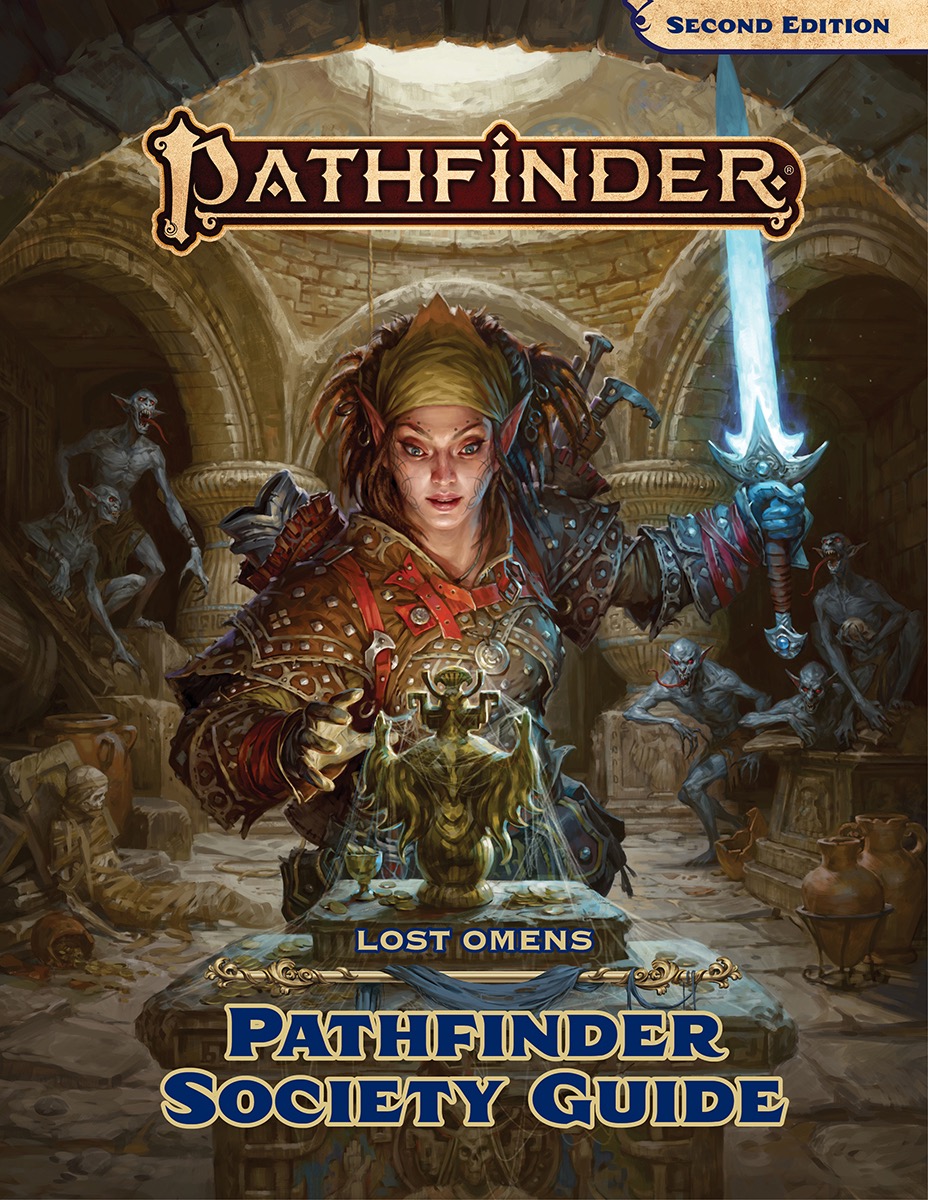Make sure to read Jason’s review of the Pathfinder Second Edition Core Rulebook, as well as his review of the Pathfinder Advanced Player’s Guide, Pathfinder Lost Omens: Legends, Pathfinder World Guide, Character Guide, Gods & Magic, Gamemastery Guide, and Bestiary 2.
If you enjoyed this review make sure to check out our new Pathfinder Adventure Path: Agents of Edgewatch Podcast and our Tales from the Black Lodge Podcast.
You never know who’s reading this stuff for the first time, so I’ll start with the basics: what IS Pathfinder Society?
And the answer is it’s actually TWO things.
First, there’s “Pathfinder Society”, the game mechanic, which I’ll introduce, and then we won’t talk about much anymore. Pathfinder Society Organized Play (the formal title) is primarily a way to create a level playing field for when people from different gaming groups sit down at a new table together – think conventions, game days at local gaming stores, and so on. In your home game, you might be a Level 7 with magic items in every slot; while I might be a Level 7 with the set of armor I started the game with, going without food to afford my first +1 weapon rune because my GM likes inflicting pain. Society Play creates a set of rules that keep everyone’s characters at ROUGHLY the same power level so that our Level 7s will be about equivalent if we ever play together. It also provides a really loose story glue for strangers to go on an adventure together – the Society picked you as a team and gave you this mission. And for some players, that’s all it is – the reason for the orc-slaying season.
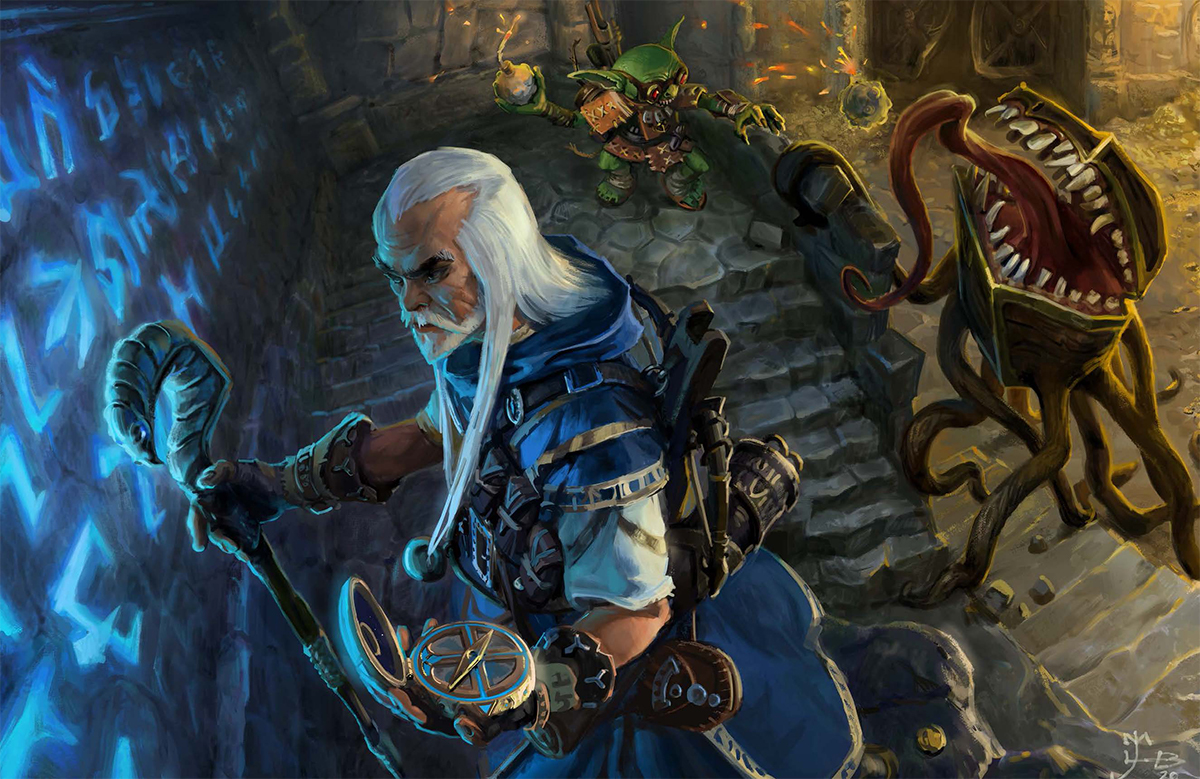
But there’s also the “Pathfinder Society” as a story element and roleplaying entity within the Pathfinder game setting. In THAT context the Pathfinder Society is an organization of adventurers, knowledge seekers, and general do-gooders who band together to go on adventures. The Society is organized physically in the form of “lodges” (think: branch offices) scattered throughout Golarion, each one run by a “Venture-Captain”. Within the Society there are different factions that may have different goals, much like different majors at a university – one group might be adventuring to get rich, another might want to preserve knowledge, still, another might want to prove themselves in combat against the toughest opponents. And sitting atop all of that is the Decemvirate – a council of 10 masked individuals who run the Society as a whole.
But how does it fit into the actual world of Pathfinder? What are these factions? Where are these lodges? How much morally ambiguous grave desecration is involved? To ask the immortal question of Starship Troopers, “Would you like to learn more?”. If the answer to that last question is yes, Paizo has the book for you: the Lost Omens Pathfinder Society Guide. It’s actually completely indifferent to the first of those two definitions. There’s nothing in this book that explicitly mentions the rules of Society play. The focus of this book is more about applying the storytelling elements of the Society to regular non-Society games.
In terms of book logistics, it’s about 130 pages long. There are two primary sections – Factions and Lodges – with small sections at either end serving as the bread of the Society Sandwich. So let’s get into it, shall we?
The opening section (notwithstanding one page of new character backgrounds) is the history of the Pathfinder Society itself. The Society starts humbly enough, with a bunch of adventurers BS’ing about their deeds at a bar, and ends up as a worldwide organization that’s curiously meddlesome about what gear you can take out into the field with you. (Sorry… game mechanic creeping in again.) Among other things, this section serves as a stealth “catch-up” for First Edition players, outlining what’s been going on with the Society between editions. Along with the history, we also get a high-level description of the organization and its place in the world – their leadership structure and rules, who likes them, who mistrusts them, the means of joining and leaving, and so on.
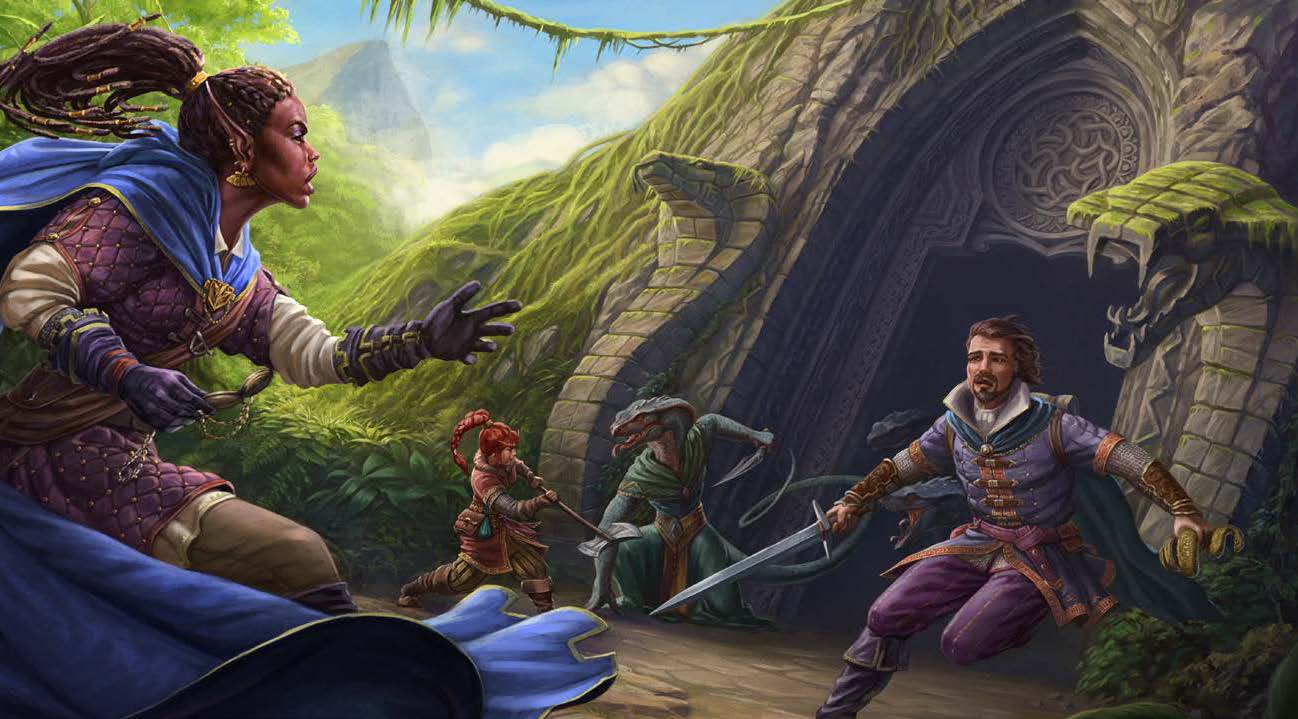
The next chapter, and the first of the two big ones, covers factions within the Society. If you’ve never played a Society game, there are shades of the Hogwarts “houses” in Pathfinder Society, where you choose a faction aligned with your goals as a character. Only there’s no “evil one” and no “other one” where they put the kids who aren’t brave, smart, or evil.
Over the course of a decade of First Edition, there was a bit of “faction creep” and there are currently 14 different First Edition factions to choose from. In Second Edition, they scaled that back a bit – there are now four “official” factions that represent the core values of the Society and two secondary factions. (The in-story reason is that the Society had to re-evaluate things after the Whispering Tyrant wiped out a huge chunk of their agents.) The in-game factions are:
- The Envoy’s Alliance emphasizes teamwork and diplomacy, building relationships within the Society and with the larger world. They arguably have the best backstory – their original faction was left to die by the rest of the Pathfinders not mounting a rescue operation for one of their missions; their leader survived and founded the “we’re not doing that again” faction.
- The Grand Archive is all about seeking out and preserving knowledge. Their motto is probably “IT BELONGS IN A MUSEUM!” in Elvish runes.
- The Horizon Hunters want to travel to unexplored places. They see gray on the mini-map, they want to fill it in.
- The Vigilant Seal is the muscle of the Society, focused on protecting the book-nerds and diplomats, or just wanting to perfect their own combat skills. Action 1: me hitting you. Action 2: you hitting the floor. Third action reserved for drinking ale.
- There are also two “lesser” factions – they have official recognition, but not on the same level as the Big 4. These are the Verdant Wheel (protectors of nature) and Radiant Oath (general “do good in the world”).
In terms of content, each of the Big 4 factions gets a few pages of general information (history, goals, and such), a profile of the faction’s leader, some gear unique to that faction, and a list of notable faction NPCs in the sidebar. The lesser factions… they just get acknowledged as existing. “S’up, Verdant Wheel!” I think my favorite piece of gear here is the “Bookthief Brew” – an item associated with the Grand Archive. You pour it over a scroll or two pages of a book, wait for it to dry, and then pull it off and it preserves the text (though not any magical effects). The Young People may not get it, but people my age will recognize this as Silly Putty. NOW STRETCH IT TO MAKE DICK TRACY’S CHIN EVEN MORE RIDICULOUSLY LARGE!
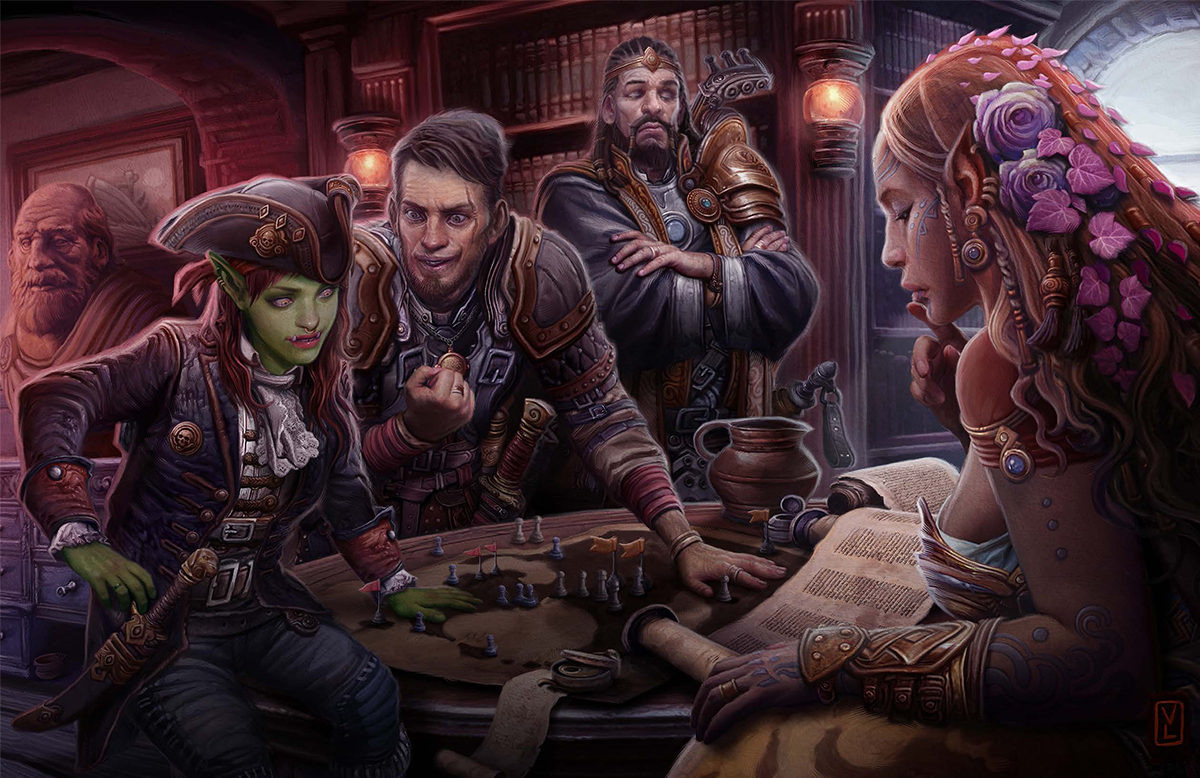
Along with the factions, we get sections on the other major structures of the Pathfinder Society.
First up are the three schools that offer training within the Society – Scrolls (pursuit and preservation of knowledge), Spells (magic), and Swords (combat). In formal Society Play, these are most useful as a source of consumable items at the start of each adventure, but in this book, we get additional character feats associated with each school (and spells for the magical ones) that can be added with the appropriate archetype. To pick an example, the Scrollmaster can take “Foolproof Instructions”, which allows them to create a scroll that an ally (even one not trained in magic) can use as part of their daily preparations. Or there’s the Spellmaster’s “Communal Sustain” which lets the caster transfer the ability to Sustain a spell to the person it was cast on for one round (presumably freeing the caster up to do other things). There are also some feats that can be taken by ANY Pathfinder Agent as well.
Next is a section on the Decemvirate – aka “the Ten”, the council of 10 that run the Society – and short sketches of about 30 NPC’s, some formal members of the Society, others just powerful allies, who are “people of influence” within Society circles. The Decemvirate themselves wear masks that both physically and magically conceal their identities, so their section is more about their leadership in general; the list of NPCs is more of a hard lore-dump a GM can use to create touchpoints for incorporating the Society into adventures that aren’t formally written with Society hooks.
Though OK… I can’t be the only one thinking it… you’ve got 20-some NPCs on that list. Wouldn’t be a total stretch to think some of those are actually members of the Decemivrate. JUST SAYIN’.
Moving on, we come to the next of the two BIG sections: Lodges. As mentioned above, think of these as the branch offices of the Pathfinder Society and local bases of operations where your characters can get missions, buy and sell gear, rest and recover between fights, and so on. The Grand Lodge in Absalom is the biggest and most prominent lodge, and where the Ten occasionally meet to conduct Society-wide business, but this section lays out 11 prominent lodges and a two-pager at the end lays out the basics of another baker’s dozen “lesser” lodges.
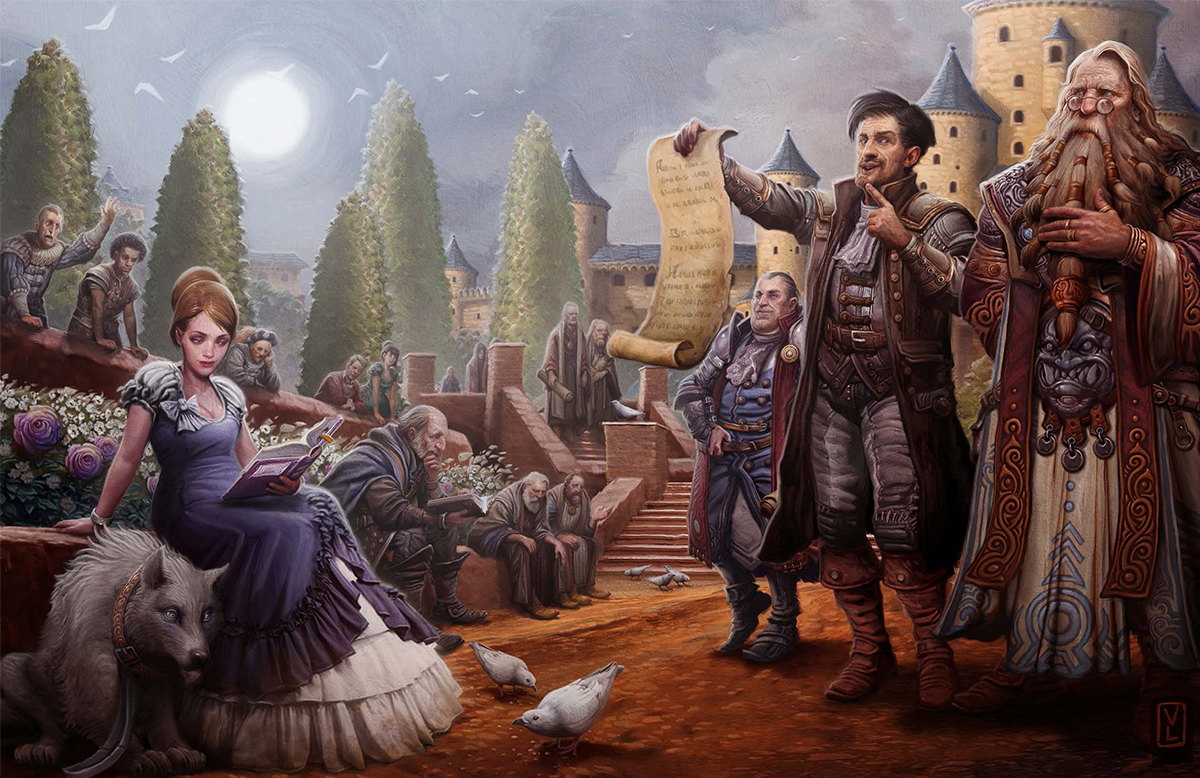
At a nuts and bolts level, the write-ups for the major lodges give you a history of the lodge itself and information on the sort of local affairs the lodge tends to get involved in, details about the Venture-Captain and other significant NPCs you might meet there, often a piece of equipment or two associated with that lodge, and a few other pieces of trivia. One of the most interesting things about the different lodges is the degree of local flavor they incorporate – it’s not like the equivalent of a big-box store where all the lodges are basically the same. The Exalted Lodge in Razmiran, which is mere miles from the Whispering Tyrant’s forces is basically a defensible fortress. The Lantern Lodge in the Chinese-influenced Tian Xia region is similarly influenced in its architecture. The Iceferry Lodge in the frozen north is more of a Viking longhall (and they have a pair of magic snowshoes as a gear option). And that doesn’t even get into the Grinning Pixie – a “lodge” that’s an actual pirate ship. The write-up for the minor lodges just gives you a brief description (repurposed cathedral, bait and tackle shop, mental hospital) and the name of a Venture-Captain.
(I should also mention there’s also a nice little callback here for people who have been listening to our Tales from the Black Lodge Podcast show, as the Exalted Lodge featured prominently in one of the adventures we played through.)
The last section (about 10 or so pages) is “Pathfinder Society Options”. This is a bit of a grab bag of other “stuff” you can get by involving yourself with the Pathfinder Society. There are selections of both non-magical and magical gear, services that can be hired through a lodge (“fixer” and “researcher” being the two introduced here), even a selection of NPC trainers that can teach a character feats they likely can’t learn anywhere else and a few familiars. To pick a few examples of “generally cool stuff”: Pathfinder agent and pirate captain Stella Fane can teach you how to throw playing cards as weapons, turning you into Gambit from the X-Men, while Meleeka Sanvara is a monk who can teach other monks a fire-oriented stance which gives both fire damage and imparts fire resistance. The Society-themed magic items tend to be either wayfinders that have different effects from the basic wayfinder, or aeon stones to slot into them, though there are a few other choices as well.
In conclusion, the question I always come down to: do you need this book at your table? It’s funny. Going in, I assumed my answer was going to be “not unless you play a whole lot of Pathfinder Society Organized Play”, but I have to admit my preconception going in was completely wrong. This book doesn’t CARE if you play formal Society play or not; in fact, quite the opposite. It deals almost entirely with the Society as one of the dominant adventuring entities in the Golarion setting. Since Society adventures sometimes treat the Society itself as a black box (put mission parameters in, money and experience come out the other end), it’s actually nice to have a book that fills in those gaps. And it’s got some decent options for player characters as well. As a softer “lore” book, it may be better for tables where the GM brews their own content, but I think a lot of tables could find some room for this one on their shelf.

